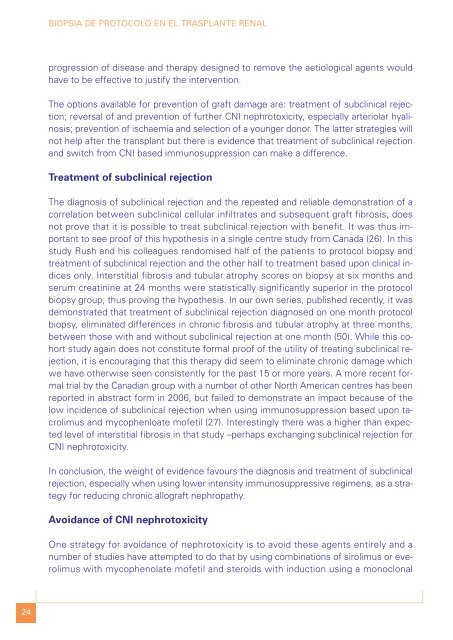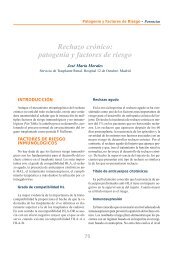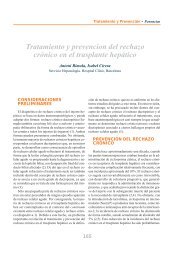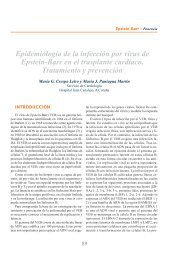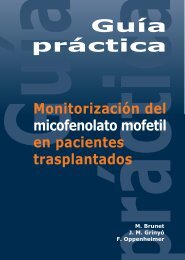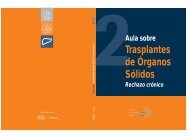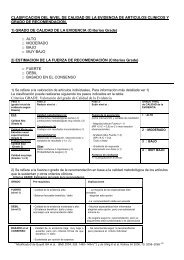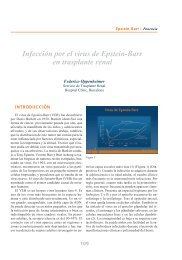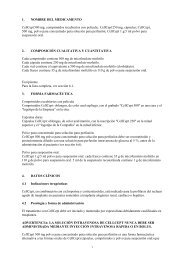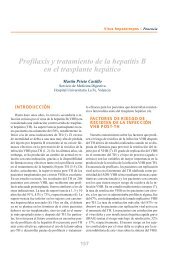Untitled - Roche Trasplantes
Untitled - Roche Trasplantes
Untitled - Roche Trasplantes
You also want an ePaper? Increase the reach of your titles
YUMPU automatically turns print PDFs into web optimized ePapers that Google loves.
BIOPSIA DE PROTOCOLO EN EL TRASPLANTE RENAL<br />
progression of disease and therapy designed to remove the aetiological agents would<br />
have to be effective to justify the intervention.<br />
The options available for prevention of graft damage are: treatment of subclinical rejection;<br />
reversal of and prevention of further CNI nephrotoxicity, especially arteriolar hyalinosis;<br />
prevention of ischaemia and selection of a younger donor. The latter strategies will<br />
not help after the transplant but there is evidence that treatment of subclinical rejection<br />
and switch from CNI based immunosuppression can make a difference.<br />
Treatment of subclinical rejection<br />
The diagnosis of subclinical rejection and the repeated and reliable demonstration of a<br />
correlation between subclinical cellular infiltrates and subsequent graft fibrosis, does<br />
not prove that it is possible to treat subclinical rejection with benefit. It was thus important<br />
to see proof of this hypothesis in a single centre study from Canada (26). In this<br />
study Rush and his colleagues randomised half of the patients to protocol biopsy and<br />
treatment of subclinical rejection and the other half to treatment based upon clinical indices<br />
only. Interstitial fibrosis and tubular atrophy scores on biopsy at six months and<br />
serum creatinine at 24 months were statistically significantly superior in the protocol<br />
biopsy group, thus proving the hypothesis. In our own series, published recently, it was<br />
demonstrated that treatment of subclinical rejection diagnosed on one month protocol<br />
biopsy, eliminated differences in chronic fibrosis and tubular atrophy at three months,<br />
between those with and without subclinical rejection at one month (50). While this cohort<br />
study again does not constitute formal proof of the utility of treating subclinical rejection,<br />
it is encouraging that this therapy did seem to eliminate chronic damage which<br />
we have otherwise seen consistently for the past 15 or more years. A more recent formal<br />
trial by the Canadian group with a number of other North American centres has been<br />
reported in abstract form in 2006, but failed to demonstrate an impact because of the<br />
low incidence of subclinical rejection when using immunosuppression based upon tacrolimus<br />
and mycophenloate mofetil (27). Interestingly there was a higher than expected<br />
level of interstitial fibrosis in that study –perhaps exchanging subclinical rejection for<br />
CNI nephrotoxicity.<br />
In conclusion, the weight of evidence favours the diagnosis and treatment of subclinical<br />
rejection, especially when using lower intensity immunosuppressive regimens, as a strategy<br />
for reducing chronic allograft nephropathy.<br />
Avoidance of CNI nephrotoxicity<br />
One strategy for avoidance of nephrotoxicity is to avoid these agents entirely and a<br />
number of studies have attempted to do that by using combinations of sirolimus or everolimus<br />
with mycophenolate mofetil and steroids with induction using a monoclonal<br />
24


